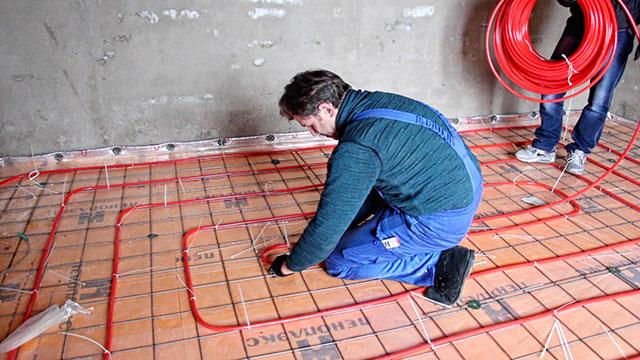The main advantages of underfloor heating include uniform floor heating over the entire area, the visual absence of heating devices and the release of space. Electric underfloor heating is a heating system based on the use of a heating cable. Water underfloor heating implies circulation through the pipes of the heated coolant.
Underfloor heating system installation by Continal Underfloor
Another fantastic underfloor heating customer testimonial for Continal Underfloor. Underfloor heating system installation “how to” …
How to Lay and Install Underfloor Heating Mats Prior to Tiling – Tile Mountain
Tile Mountain’s resident expert Craig Philips share his top tips for installing electric underfloor heating mats prior to tiling. If you’ve …
Underfloor heating can be used as the main or additional heating of the room.
Underfloor heating maintains a temperature at the floor level of +24 degrees C, in the body area +20 degrees C and at the head +16 degrees C. This is the most comfortable distribution of heat for a person.
Underfloor heating is absolutely safe, does not create electromagnetic fields, prevents drafts.
Underfloor heating can be installed with linoleum, laminate (power limits of 110 Btc / sq.m), tiles. But parquet from heating can change its characteristics.
With strict adherence to the instructions, the installation of underfloor heating can be performed independently. But since the performance of the system depends on the quality of installation, it is better to entrust this matter to specialists. Moreover, only an electrician should connect electrical equipment.
The advantages of electric underfloor heating include the visual absence of heating devices, uniform heating, the ability to adjust the temperature and local repair of malfunctions. Disadvantages – an increase in electricity bills, the appearance of a small (safe according to SNiP) amount of electromagnetic radiation.
Advantages of water underfloor heating: visual absence of heating devices, uniform heating, the possibility of heating large areas, saving on electricity.
The disadvantages include the complexity of installation and control of the system, the difficulty of troubleshooting (leaks).
For thermal calculation, you need to take into account the following factors: the type of heating (main / additional), the type of room (basement or warm rooms), the possibility of pouring a screed of 3-5 cm.
The action of the heating cable is aimed at converting electric current into heat. The cable can be single- or double-core, enclosed in two-layer insulation. A two-core cable is more convenient in the sense that its second end will not need to be returned to the thermostat. This is true for rooms with a complex configuration.
There is a difference between a warm floor under a screed and a mat. The screed accumulates heat and retains it longer, saving electricity. The cost of underfloor heating is lower. A thin mat is used if the screed is already poured or if it is not possible to pour it.
Please note that cracks in the screed (air voids) can damage the operation of underfloor heating.
To avoid this, when pouring, make the solution thinner. If cracks do appear, fill them with the solution again. The same rule (no voids) applies to the application of glue when installing a thin heating mat.
Thanks to the shielding braid along the entire cable, the warm floor is also safe in case of water leakage. Therefore, underfloor heating can be installed in bathrooms, baths, swimming pools.
The cause of a malfunction of the underfloor heating can be the failure of the thermostat, damage or burnout of the heating cable.
The heating time of the underfloor heating depends on the type of floor. A thin mat will take 2-3 hours, and a warm floor under the screed – from several hours to a day. When the set temperature is reached, the underfloor heating is automatically turned off.
The laying step of the cable can be calculated using the formula 100 S/L, where S is the laying area, L is the length of the section. The distance to the edge of a thin heating mat or a turn of the cable to the wall should be at least 5-10 cm.
If the length of the wire was not enough and it does not reach the thermostat, it can be increased with ordinary copper wire.
A underfloor heating thermostat is an electronic device that provides precise control of the cable heating system. It allows you to save electricity by adjusting the heat supply according to the specified parameters. With the help of a programmable thermostat, you can set the optimal mode of operation and adhere to it without additional control. Thermostats are installed at a height of 80-90 cm from the floor level.
Guide: How To Lay Underfloor Heating
Learn how to lay underfloor heating from an expert. Underfloor Heating Systems Ltd have years and years of experience laying ..
How to Install Electric Underfloor Heating
This video shows step by step on how to install your electric underfloor heating. If you have any questions please leave a ..
How to Install Thermonet Underfloor Heating Mat System
This video will go over how to install the Thermonet Underfloor Heating Matting System. This video includes tips and tricks to ..
Underfloor heating electric or water?
- How recondition a gradient or wet wall
- Mini oven Delta D- 0324
- Do it yourself planning a spa bar at home reviews
- Why do I need a laptop lock?
- Maintenance and repair printers
- landscaping plants pictures and names
- Repair in a small apartment
- Why does not spin washing machine
- home solutions for rust reviews
- what is surface water drainage systems

